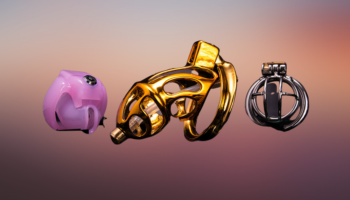A fetish refers to an intense sexual fixation on a generally nonsensual object, body part, practice, or situation. Some individuals with strong fetishes, or paraphilias, may not feel aroused or climax without their chosen fetish. According to the American Psychiatry Association, most fetishists are men. However, any person of any gender, sexual orientation, and age can have a fetish.
The term fetish comes from the Portuguese word feitico, meaning charm or sorcery. This link reflects the mysterious power that objects or situations can have over people with fetishes. Portuguese sailors and traders in the early 17th century likely used the word as a name for the talismans and charms they traded. By around 1837, the term became used figuratively for any object people revered or felt devoted to. It evolved to be a term used in a sexual sense by 1897.
There are all different types of fetishes, ranging from very common to more unusual. Some of the most common fetishes involve feet, hair, spanking, and leather. Fetishes on the less common end of the spectrum, involve robots, urine, insects, amputees, and cannibalism. If you can think of it, there’s likely to be a fetish based around it.
Fetishes usually manifest during puberty, but they can present even earlier. Experts are unsure why people develop fetishes, but some people believe early childhood experiences can trigger them. For example, if someone has a crush on a babysitter who wears high heels, they may develop a fetish for this footwear. Fetishes may also have a cultural component.
Experts believe the majority of people have some kind of fetish or hyperspecific turn-on. Some people have multiple fetishes. Some people do not realize they have a fetish, because their sexual attraction is simply a part of their ordinary sexual experience. Fetishes were once taboo, but now people discuss them openly and accept most fetishes as part of a healthy sexual identity. If they are not, for instance if non-consent is an issue, clinical intervention is necessary.
More About Fetish
People can enjoy their fetish in several ways. Some people love experiencing their fetish directly, using all their senses to absorb the stimulus. Others love observing other people in a fetish setting. For example, they might feel aroused watching someone interacting with a fetish object or in a fetish situation. Some people feel gratified with fantasies about their fetishes.
Role-playing can satisfy people with fetishes that are difficult to directly experience in the real world, such as inflation fetishes. Online materials, including pornography, erotic stories, and fetish communities can also satisfy people with fetishes.
Fetishes can make sex more exciting. Indulging in a fetish can enhance arousal and sexual experience. While some fetishes may seem unusual to people, most fetishes are totally normal. Most people live happily with their fetishes and accept them as part of their sexual identities. As a general rule, a fetish is harmless if it enhances your libido or sex life.
A fetish may be a problem if it encroaches on someone's everyday activities, causing mental distress and unusual behavior. Fetishes may be a problem if someone can’t enjoy sex without them or they struggle to form relationships and meet their responsibilities. Fetishes may also be a problem if they encourage people to hurt others or otherwise break the law.
Indulging in fetishes must always be informed and consensual and that fetishes that include non-consensual activity (with minors, animals, etc.) must be addressed through therapeutic interventions.
When someone experiences these problems, psychiatrists may say they have fetishistic disorder. Psychiatrists may give this diagnosis if someone experiences recurrent, intense fantasies and urges focused on their fetish for at least six months that they find distressing or disruptive.
People with fetishistic disorder usually don’t experience the same pleasure from their fetish as people with healthy fetish interests do. They may feel ashamed or disgusted by their fetish. Sometimes the distress is from cultural norms or religious expectations that induce shame where there should be none and that this means therapy should focus on embracing who one is not; to erase the fetish.
Counseling and therapy techniques, such as cognitive-behavioral therapy, can help people retrain their brains and manage fetishistic disorder.



